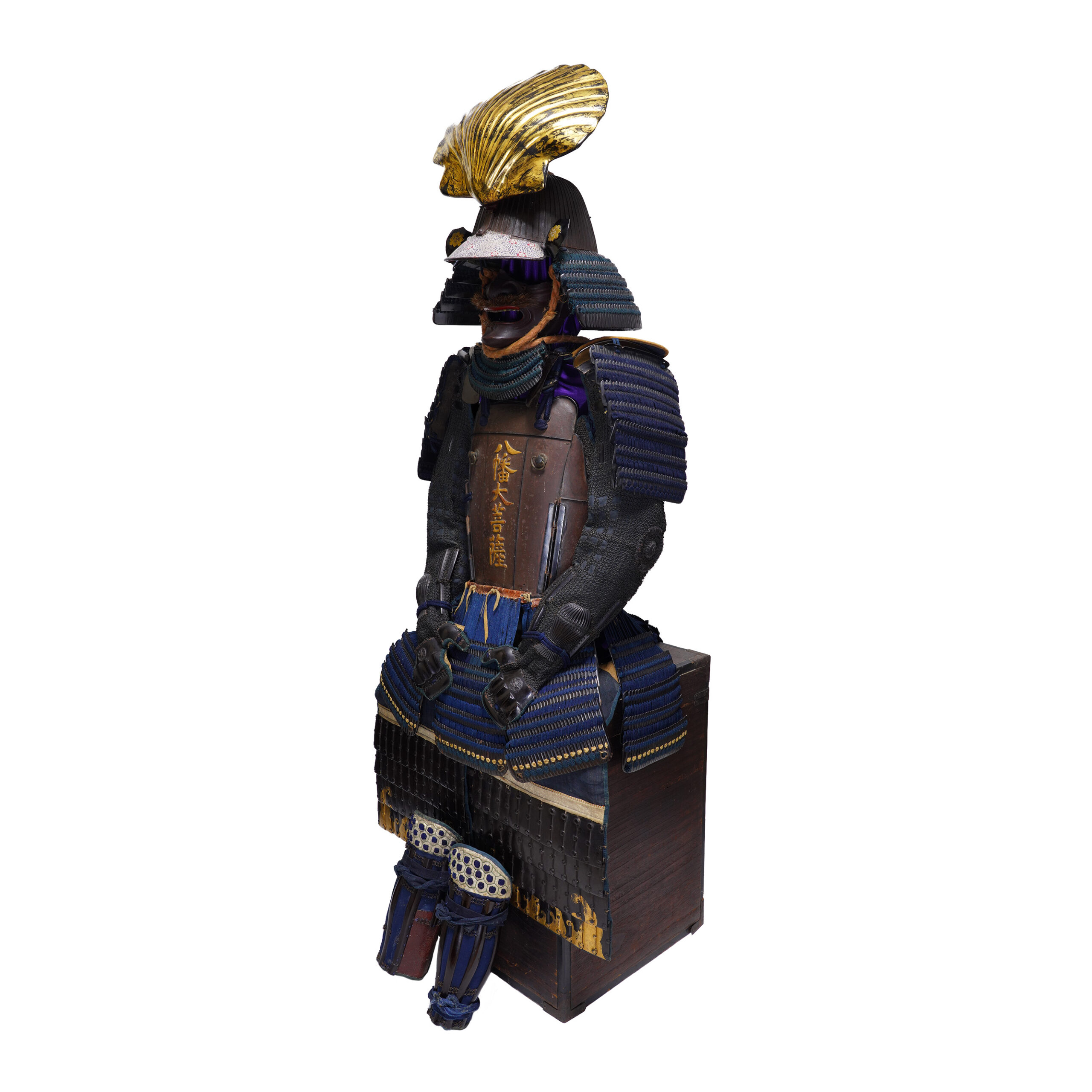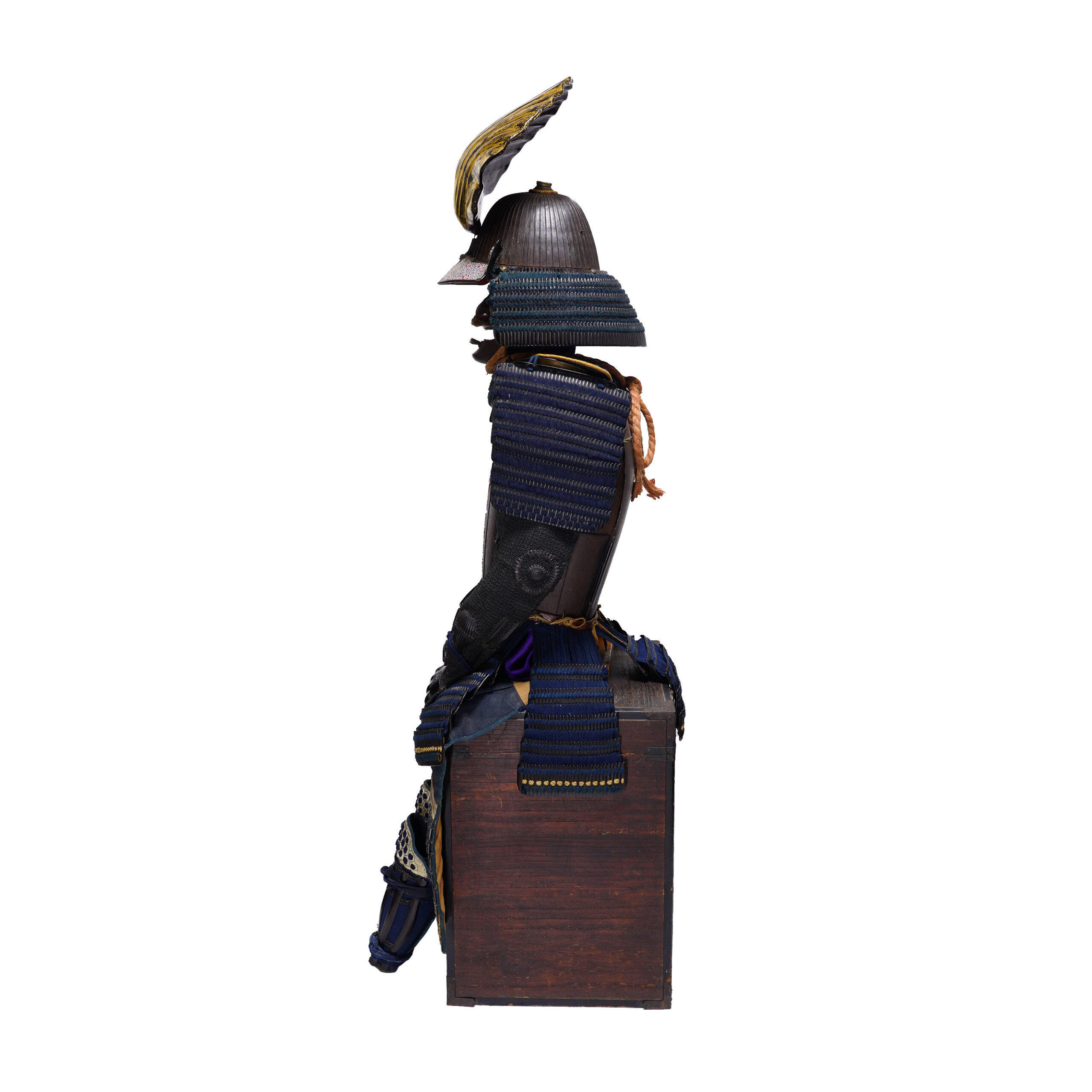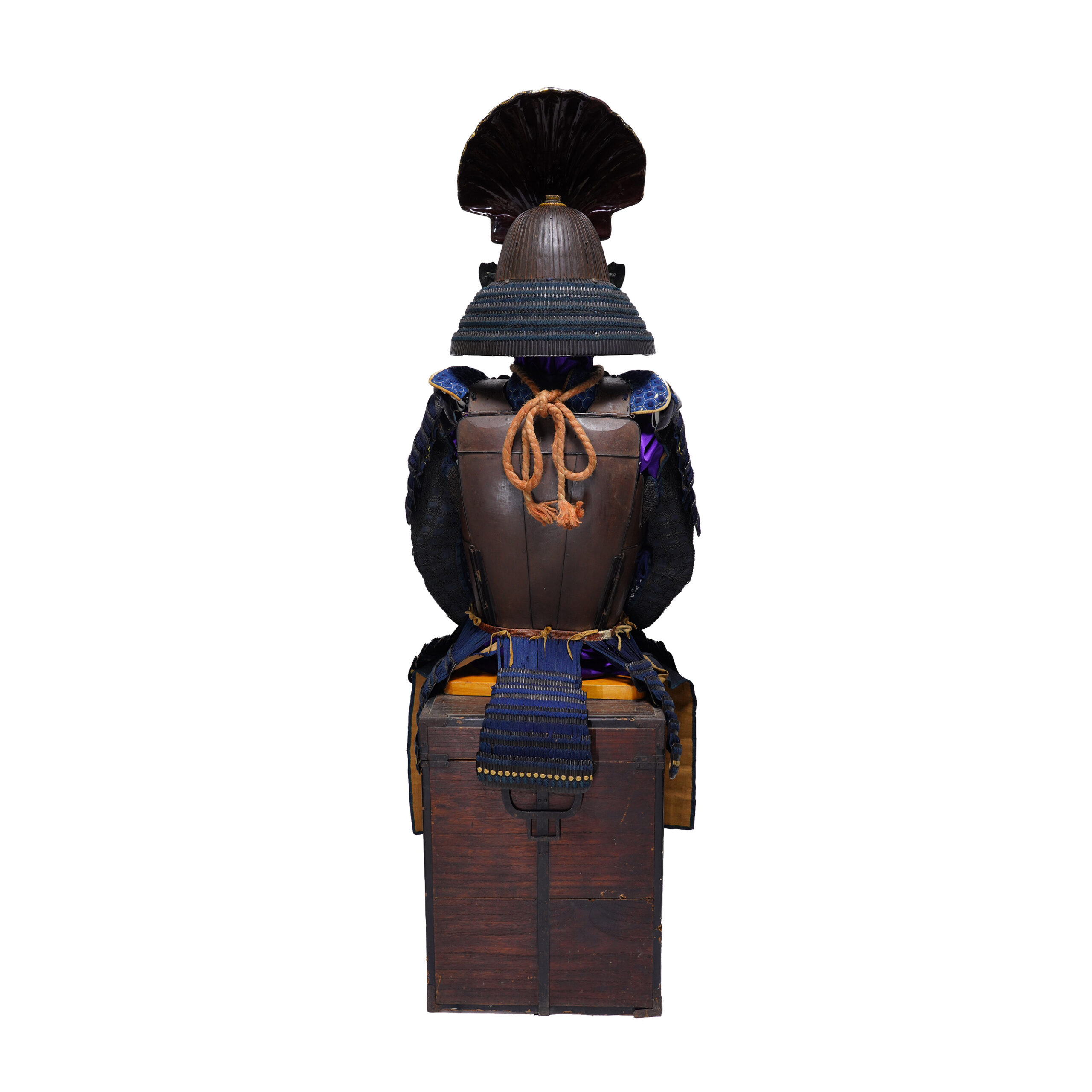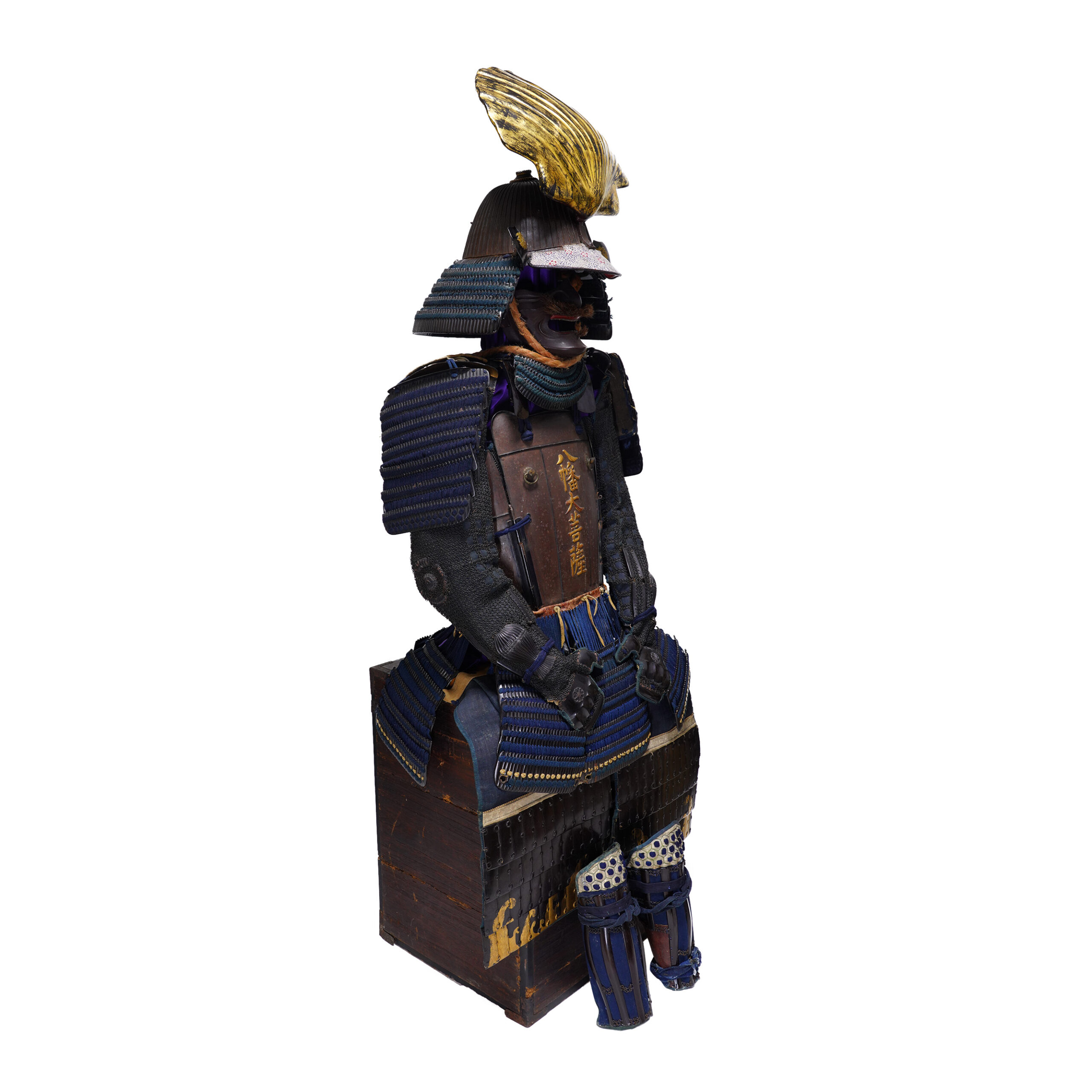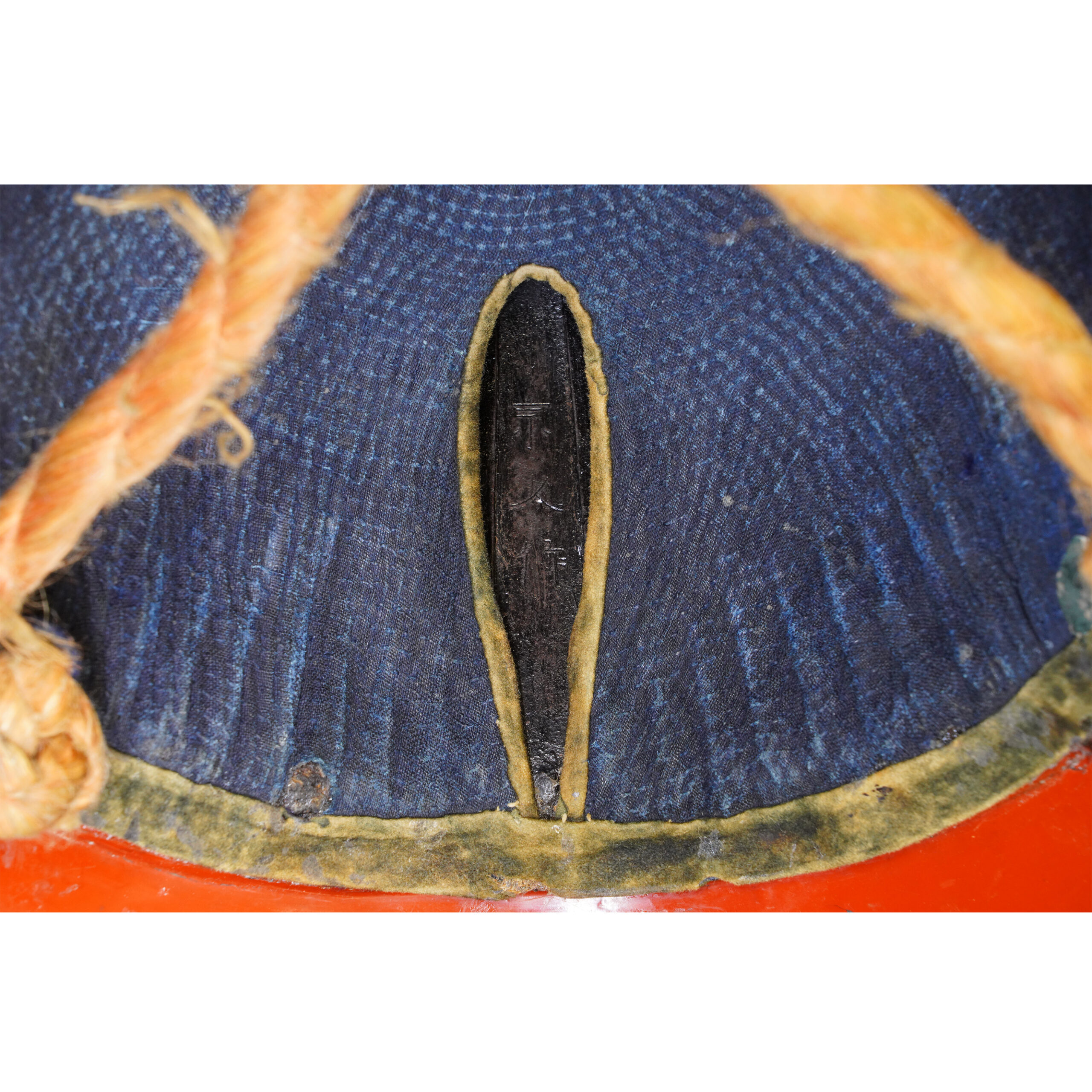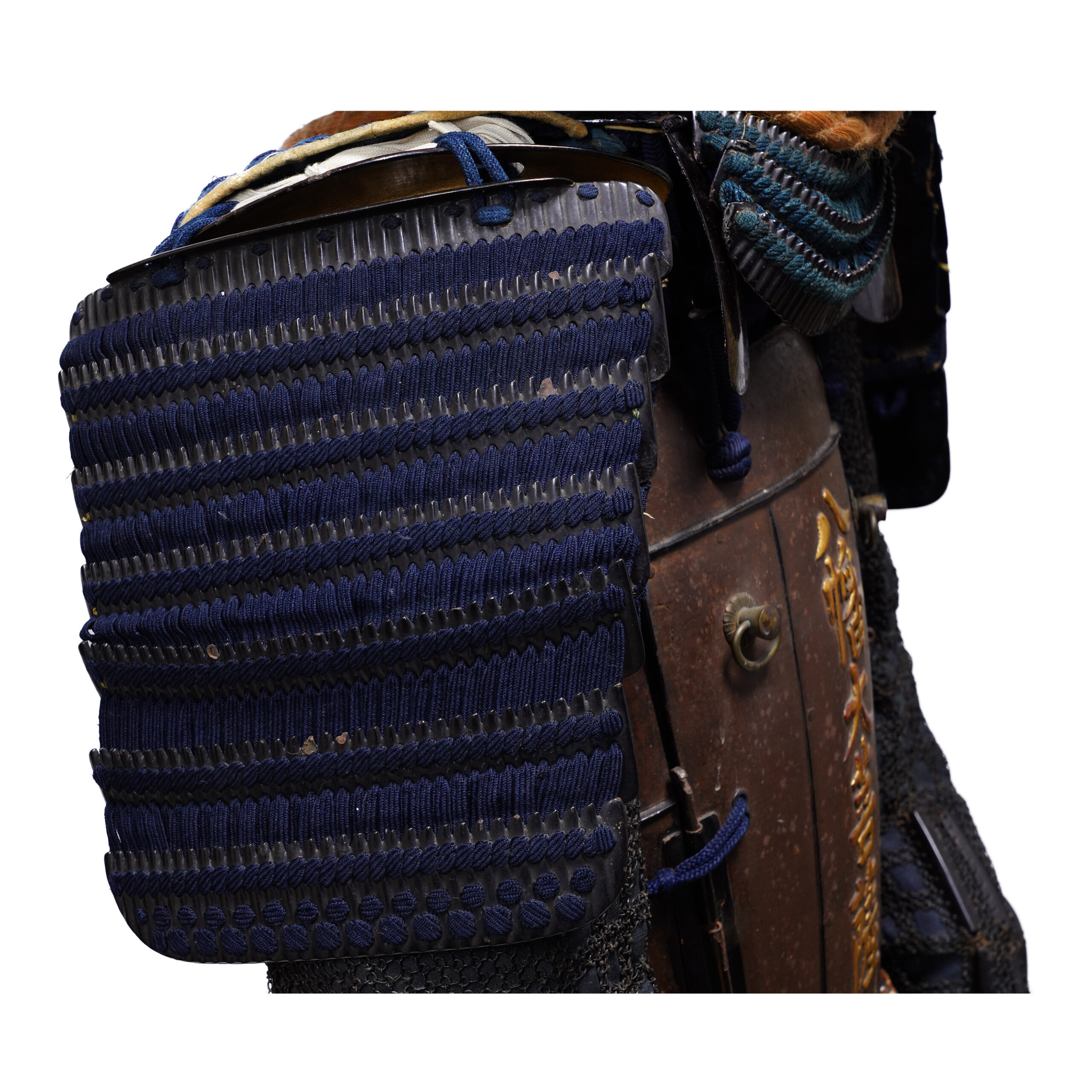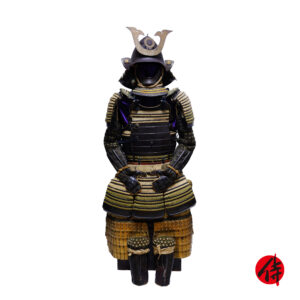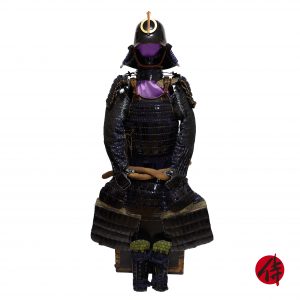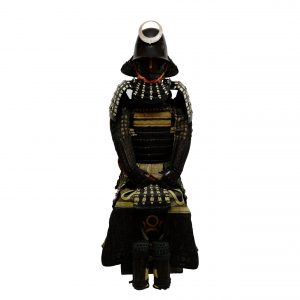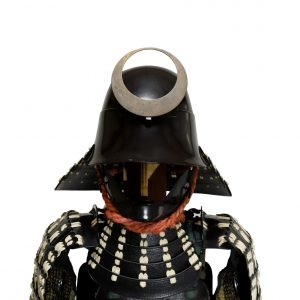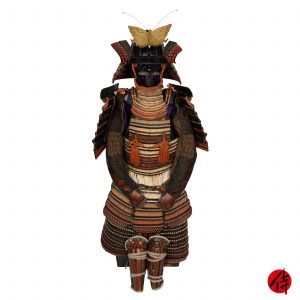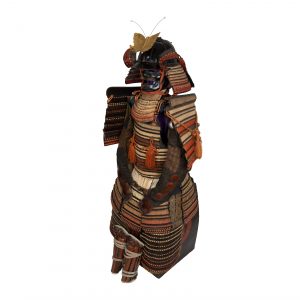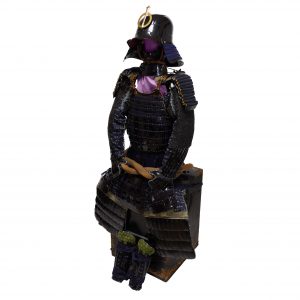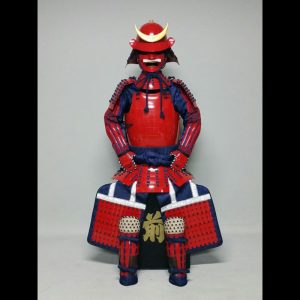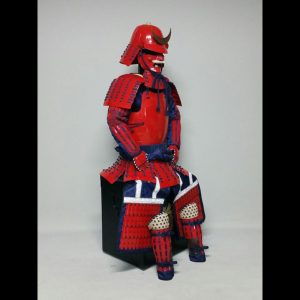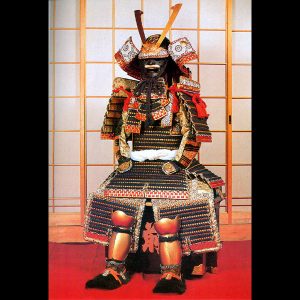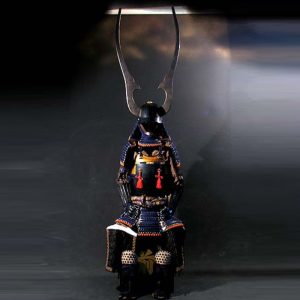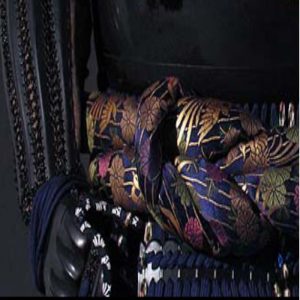Antique Mid-Edo Period Tetsusabiji Gomai Do Samurai Armor (A-22)
Period: the middle of the Edo Period (late 17th- early 18th century)
appraised by The Association for the Research and Preservation of Japanese Helmets and Armor
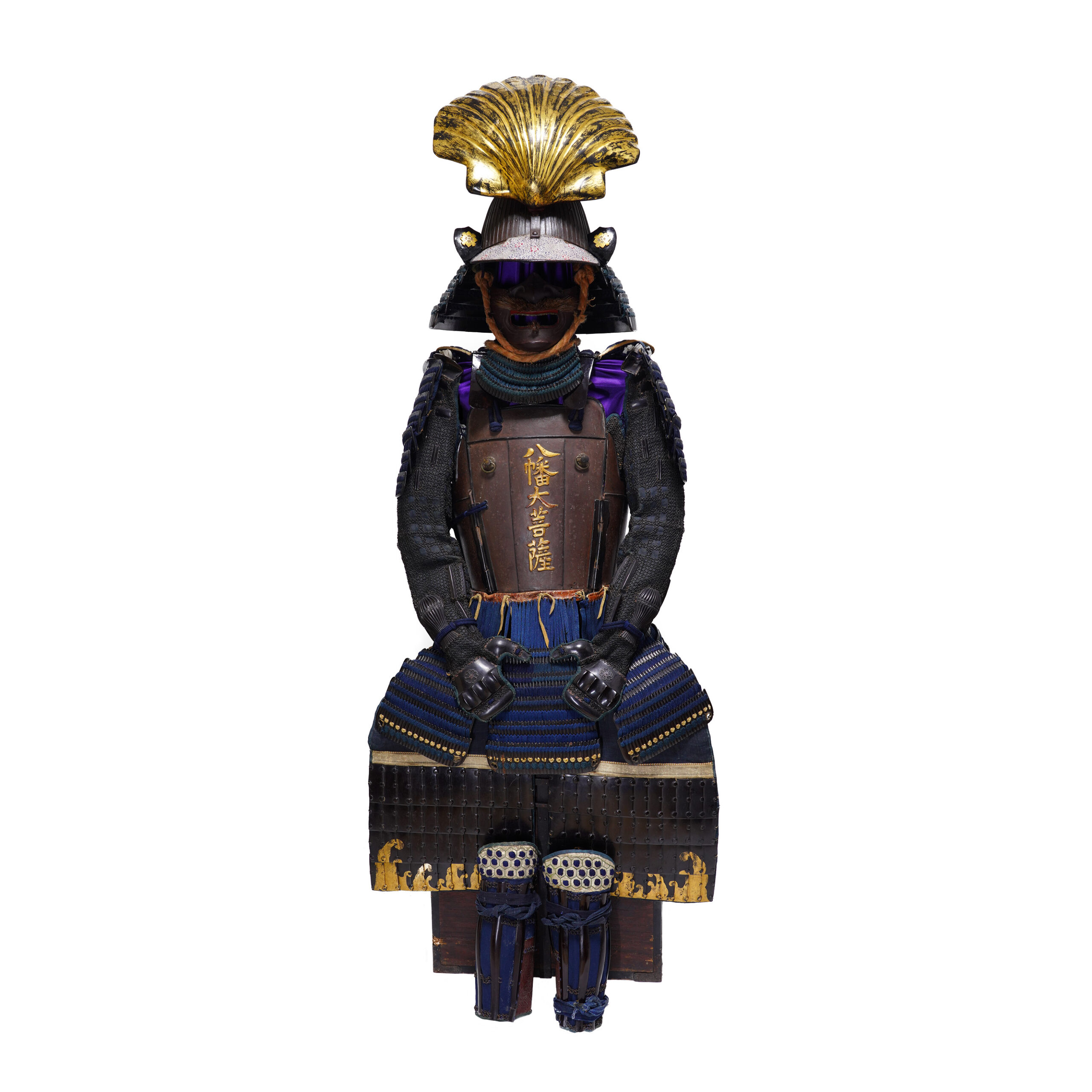
Kabuto (helmet)
■Helmet bowl: Suji Kabuto
The Kabuto (兜, helmet) is a protector for the head. When people started using the Kabuto, it was initially designed for practical use. However, the principal purpose of its design has changed with time; Samurais tried to express their dignity, personality, or religion by wearing the characteristic design Kabutos. According to a theory, these unique designed Kabutos were made from the late Muromachi period to the Edo period. This type of Kabuto is categorized as the Kawari Kabuto (変わり兜), and a variety of materials were used to create them. For example, animal fur, seashells, plants, and papers were used as materials for decoration.
Here we would like to introduce to you a little bit more about the history of Kabutos. Before the Kawari Kabuto’s production, the Suji Kabuto (筋兜) has appeared during the Nanbokuchou (南北朝, 1337-1392) period. At that time, the tactic was gradually changed from the piggyback fight style to battle with the Tachi (太刀) sword and the Naginata (薙刀, Japanese halberd) on the ground. Therefore, there was a rise in demand for the weight-saving of the Kabuto. Also, in order to turn the attack by swords, a new type of structure was invented; it is the Suji Kabuto (筋兜). Its form slides swords’ attacks when weapons hit the Kabuto. It is said that the production of the Suji Kabuto prospered in the Muromachi (室町, 1336-1573) period. We estimate this Kabuto is one of these Suji Kabutos made in that tendency in the Edo period. It has 62 stripes in this Kabuto, meaning 62 small iron plated are connected. It is called Ryokuju Ni Ken Suji Kabuto (六十二間筋兜). Rokuju Ni means 62 in Japanese. The surface is Tetsusabiji style, which only applied lacquer for paint base for the iron not to get rusty. It looks less shiny than a normal lacquered surface.
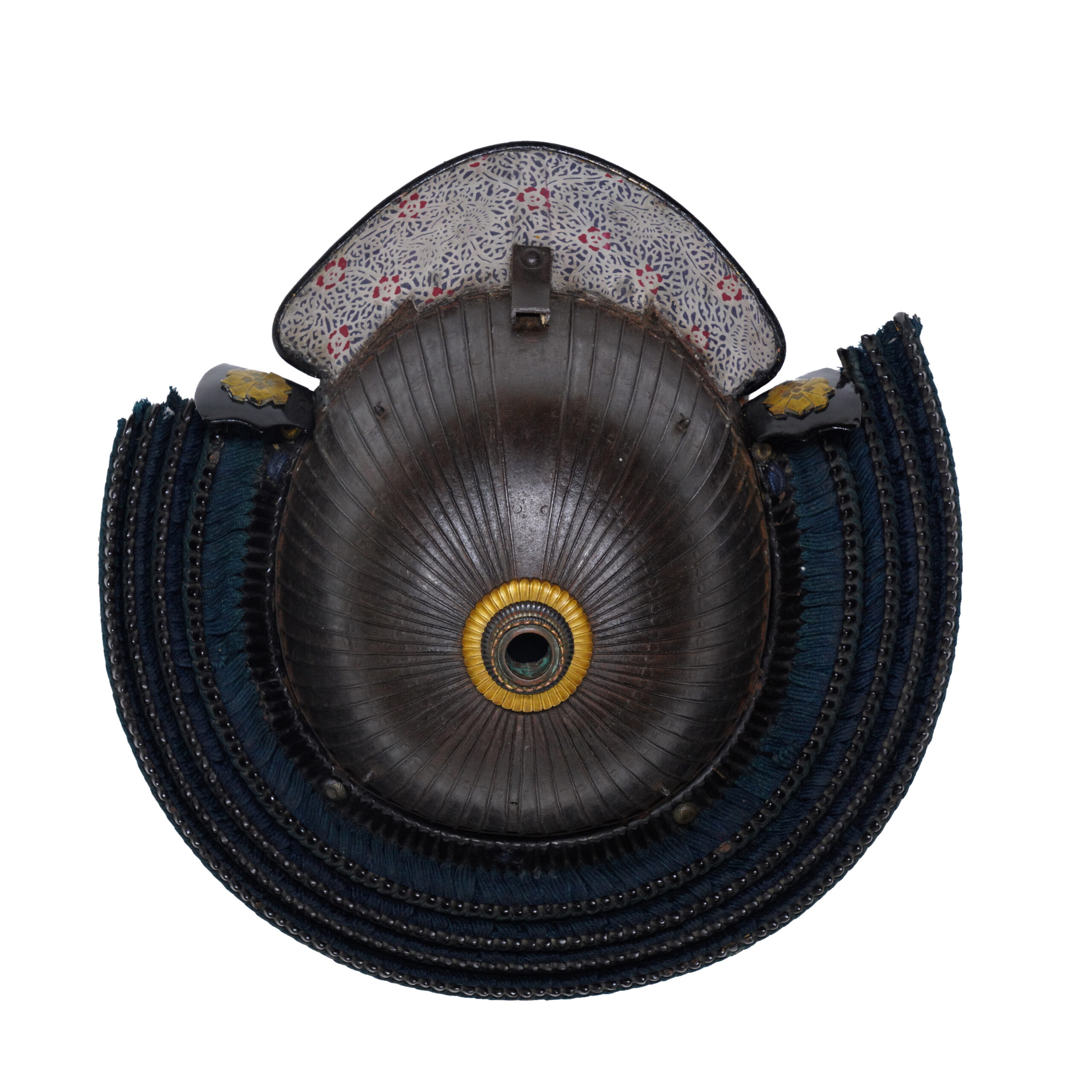
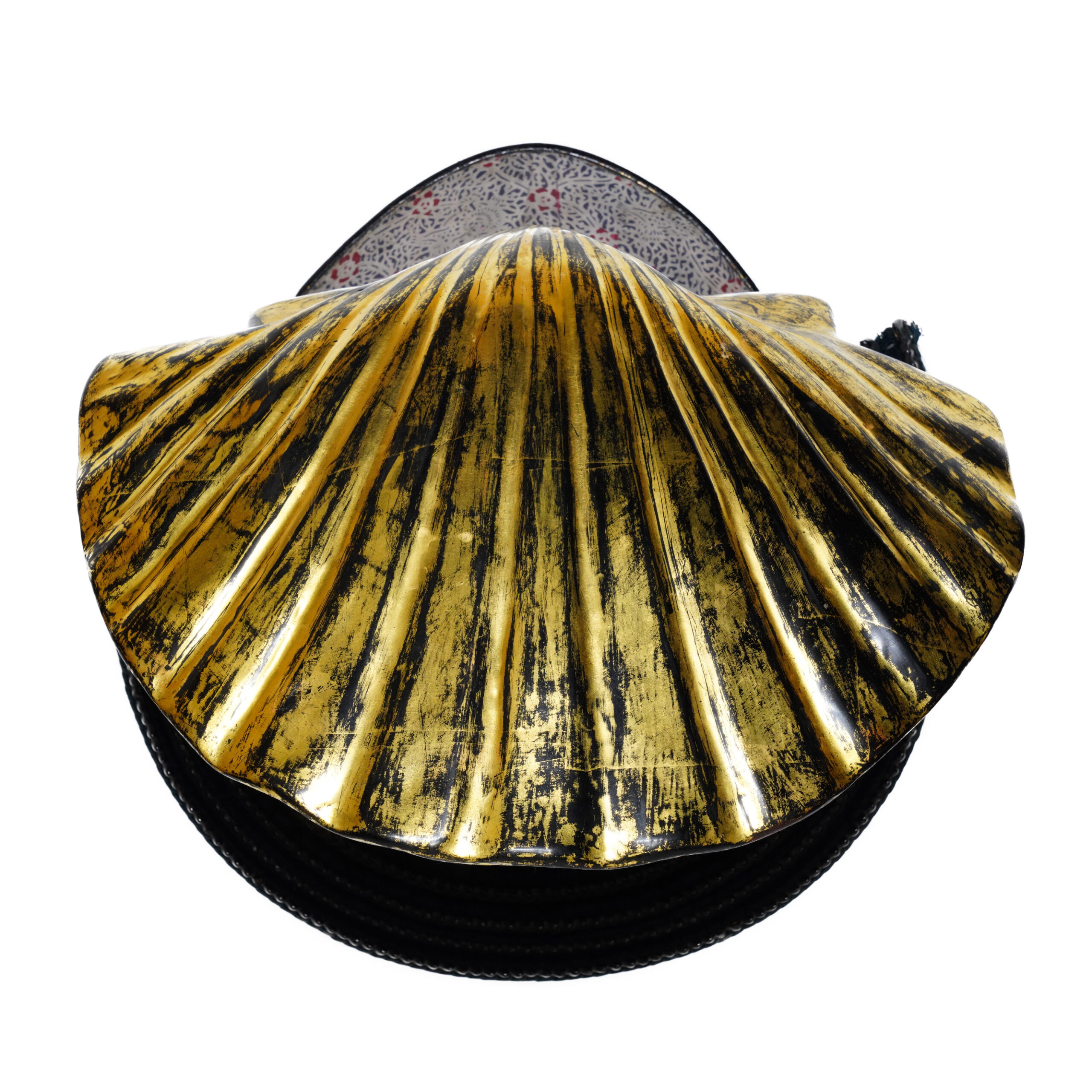
■ Mei (Signature): Munehisa Saku (Made by Munehisa)
The signature is inscribed inside the helmet. It says 宗久作 (Made by Munehisa). While the authentication paper doesn’t mention which Munehisa created this Kabuto, we assume it was made by one of Myochin school members. Myochin is the name of a famous armor-making school that has been continuing for generations since the Heian period.
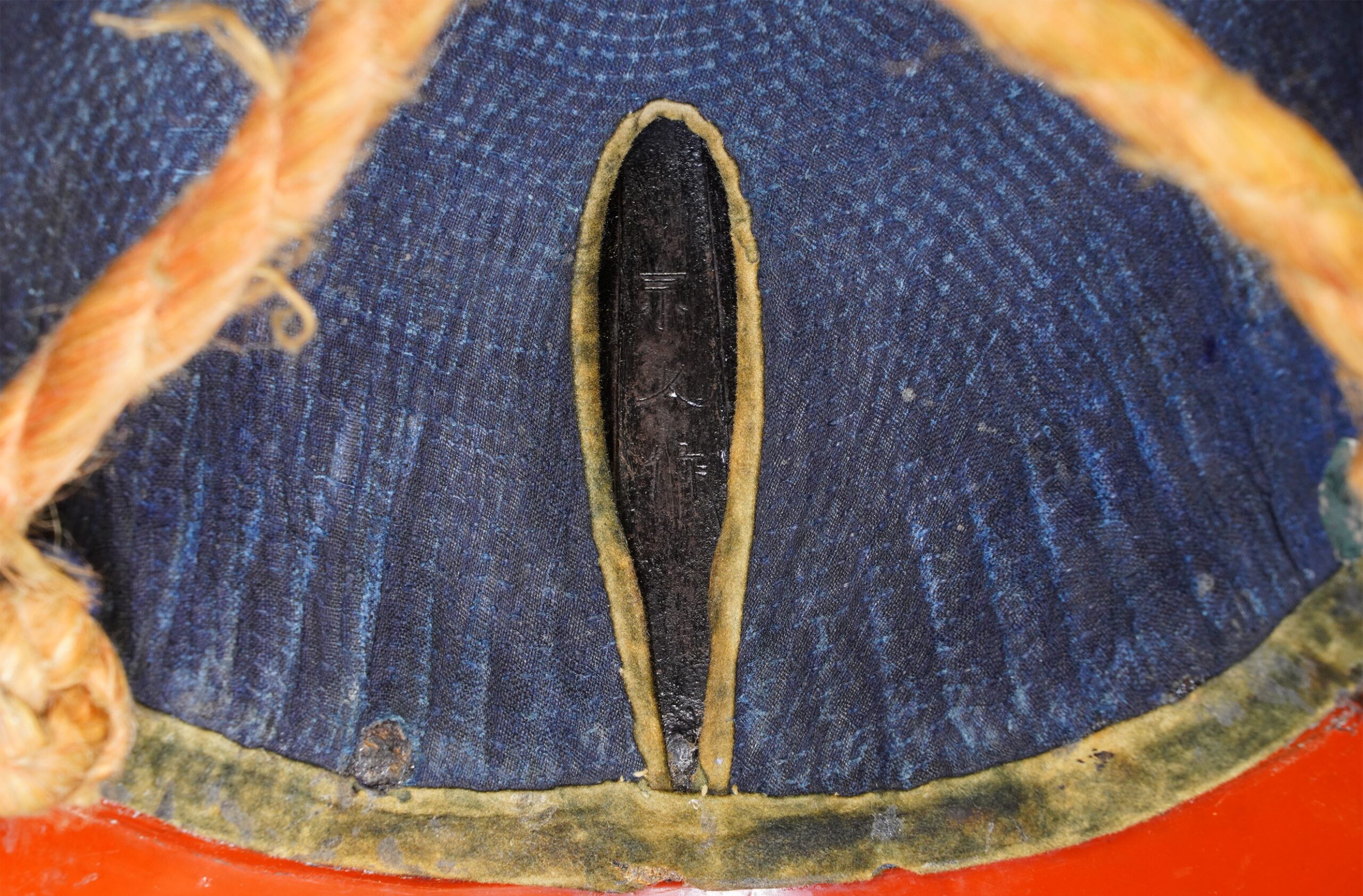
■Shikoro (side neck guard):
Black lacquer iron plates laced with navy color threads.

■Fukikaeshi (side neck guard): Kenbishi Mon
The Fukikaeshi (吹き返し) is both ends of a helmet. It protects the face from swords and also shows its beautiful workmanship. Family crests are sometimes designed on this part, as seen in this work. You would find a golden crest on the Fukikaeshi part. We are unsure of the name of this design; however, we believe it is a type of Kenbishi (剣菱) Mon. This is a combination of the Ken (剣, sword/blade) pattern and the Hishi (菱, rhombus) Mon. The Hishi Mon is a geometric pattern that has been used since ancient times. It is famous that the Kai Takeda (甲斐武田) clan have used arranged Hishi designs for their family crest.
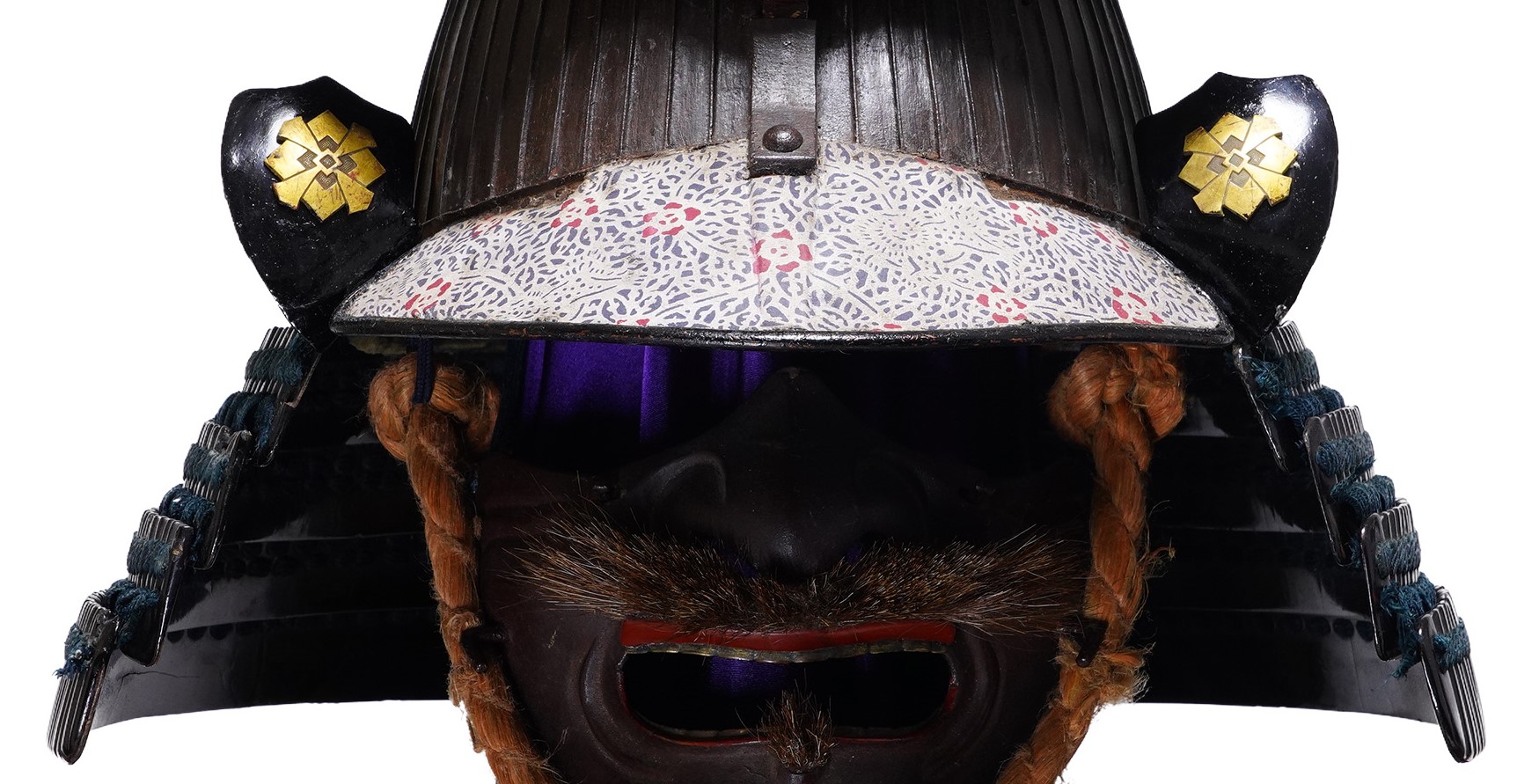
■Menpo (face guard): Ressei Menpo
Iron mask with a mustache. This type of Menpo is called Ressei Menpo (烈勢面頬). It represents the angry face to intimidate enemies. There are many types of Menpo, depending on their shape or appearance. The purpose of Menpo was not only to protect Samurai’s face. But also to hide their true faces so that their psychological states were not affected.
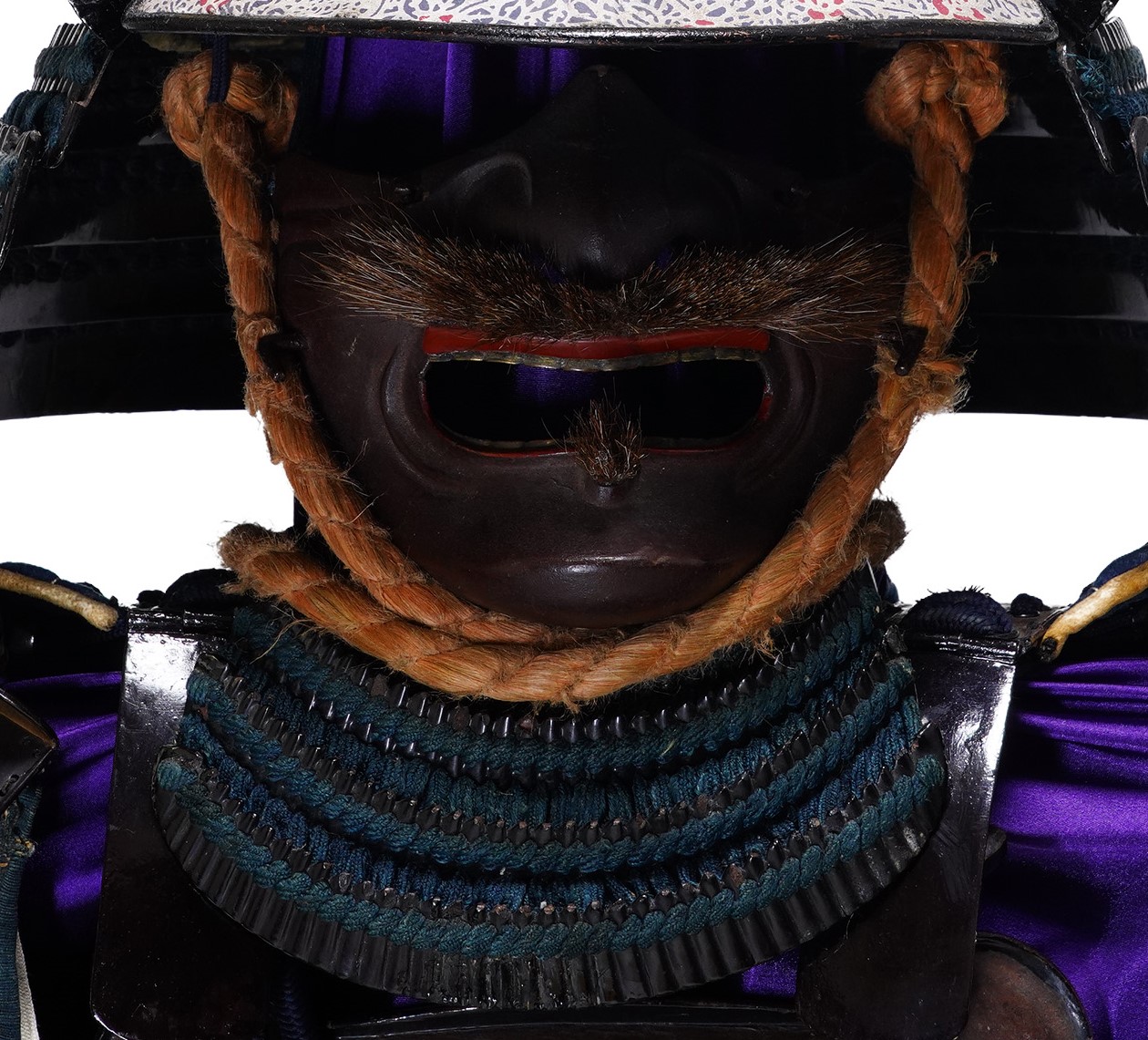
■Maedate (Front decoration): Hotate Gai
The motif of this helmet’s Maetate (前立, front decoration) is a Hotate Gai (帆立貝, scallop). Although some colorings have already faded due to aging, this Maetate still retains its gorgeous appearance. As you see, this Maetate is quite big; we imagine the Samurai who wore this armor stands out even on battlefields where many warriors were fighting and must have caught the attention of those around him.
As mentioned above, the Japanese name of this seashell is written as 帆立貝. Some people believe this motif represents the idea of Junpu-Manpan (順風満帆). It means clear sailing, which in turn means everything will go smoothly. Now you realize that the name 帆立 and the idiom 順風満帆 have a common letter: 帆. Such wordplay associations are often found in classical Japanese iconography.
In addition, another theory focuses on the shape of a scallop. Because the shape of the scallop resembles an open fan, its widening form was considered a lucky charm. This shape is called Suehirogari (末広がり) in Japanese, and people appreciate it based on the idea that this shape implies a perspective of the future.
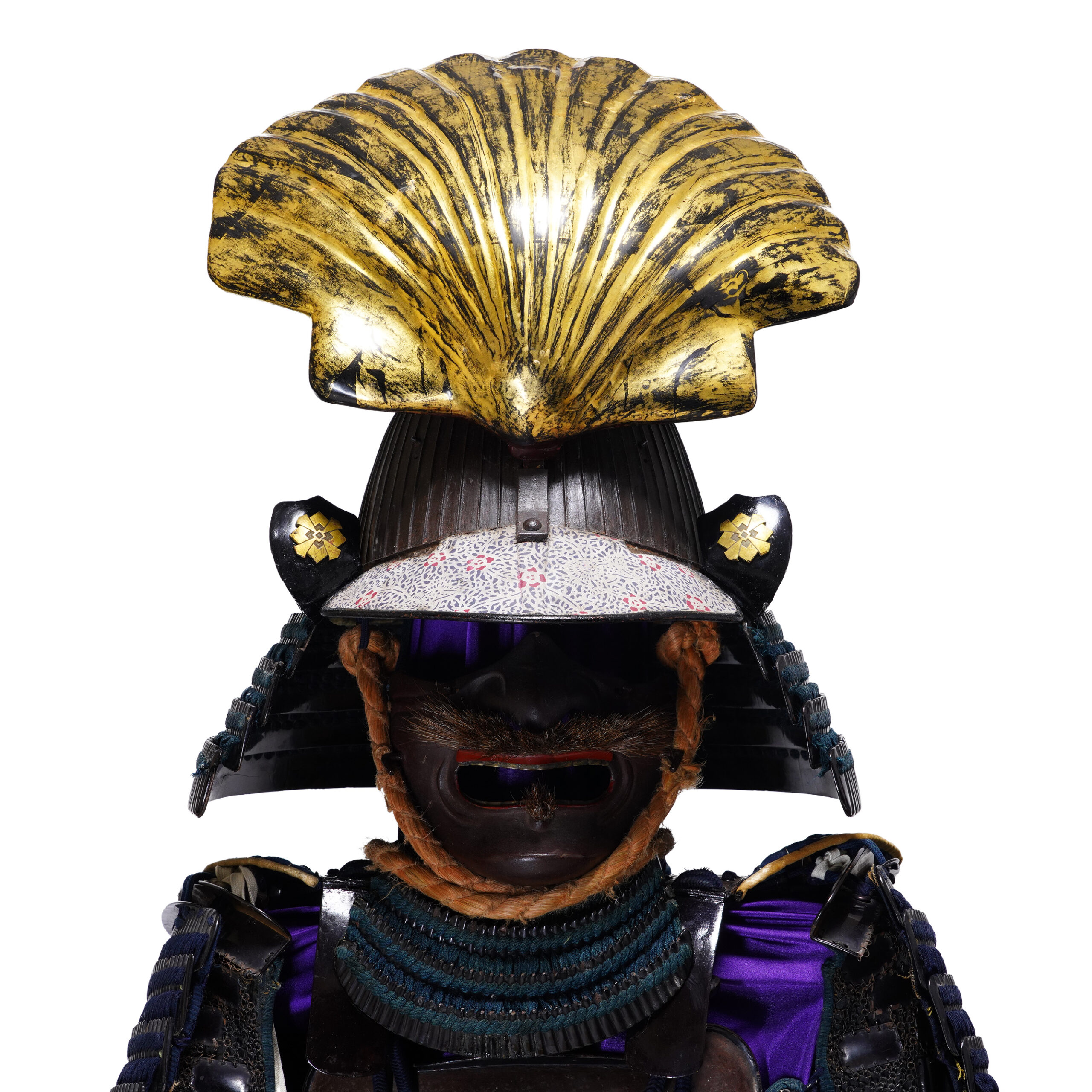
Armor
■Do (cuirass): Tetsu Sabiji Gomai Do
Gomai Do is a kind of cuirass for Tousei Gusoku (当世具足, developed armor style). Gomai Do (五枚胴) was named after the fact that Gomai (五枚) means five plates, and Do (胴) means torso in Japanese. Instead of using a large number of small lamellar plates called Kozane (小札), this cuirass used large iron plates riveted.
You would find the name of Japanese god on the front. It is written as Hachiman Daibosatsu (八幡大菩薩). It is a title of the Hachiman Jin (八幡神, Hachiman God). In ancient times, it was enshrined as an ancestor of the imperial family, and later it was worshiped as a guardian deity of Samurai families. This deity is widely worshiped throughout Japan. It is also called Hondawake-no Mikoto (誉田別命) and is identified with the Oujin Tennou (応神天皇, the 15th emperor).
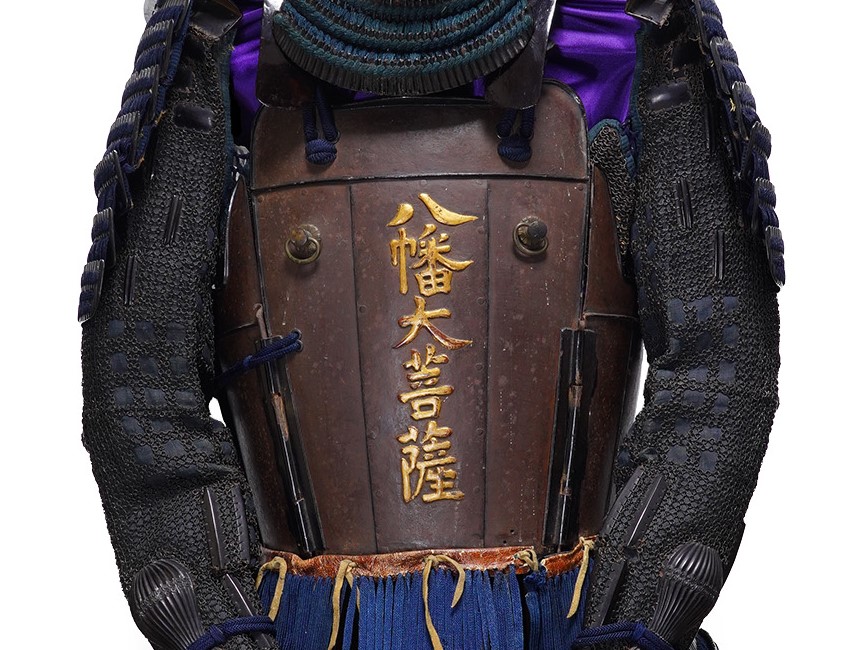
■Decoration on body armor:
■Kusazuri (skirt of plates attached to the cuirass):
Lacquered iron Kusazuri laced with navy threads.

Small parts
■Kote (armored sleeves):
Intricate iron chain mail with silk.
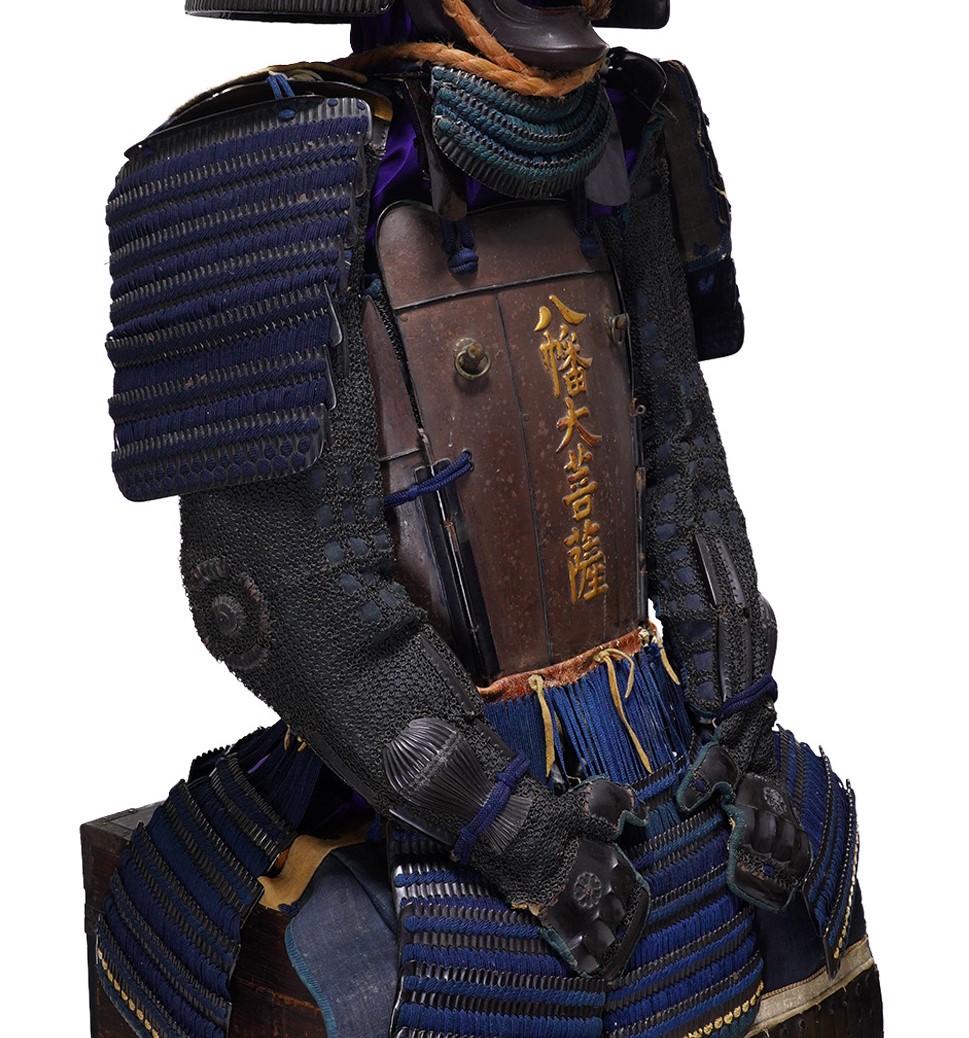
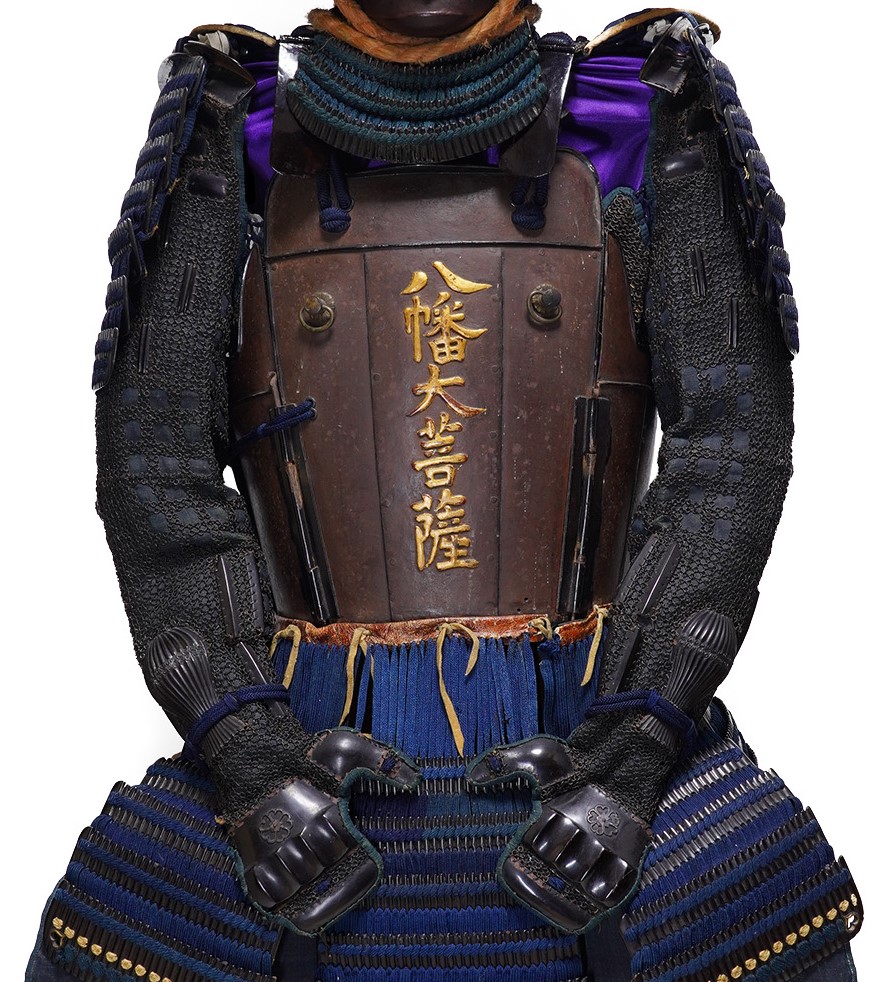
■Haidate (thigh protection): Nami pattern
The Haidate (佩楯) is a thigh guard. Black iron plates are attached to the cloth. The Nami (波, wave) pattern is designed with golden paint on the bottom of the boards arranged in four rows. As waves’ movements continue endlessly, the wave pattern represents eternity, immortality, longevity, birth, etcetera. Also, since tides repeatedly change the shape and terrain of rocks, some people hoped for a strong will by using this motif. People used this pattern wishing for an indomitable spirit to rechallenge time and time without giving up. These ideas might have inspired this Haidate’s design.
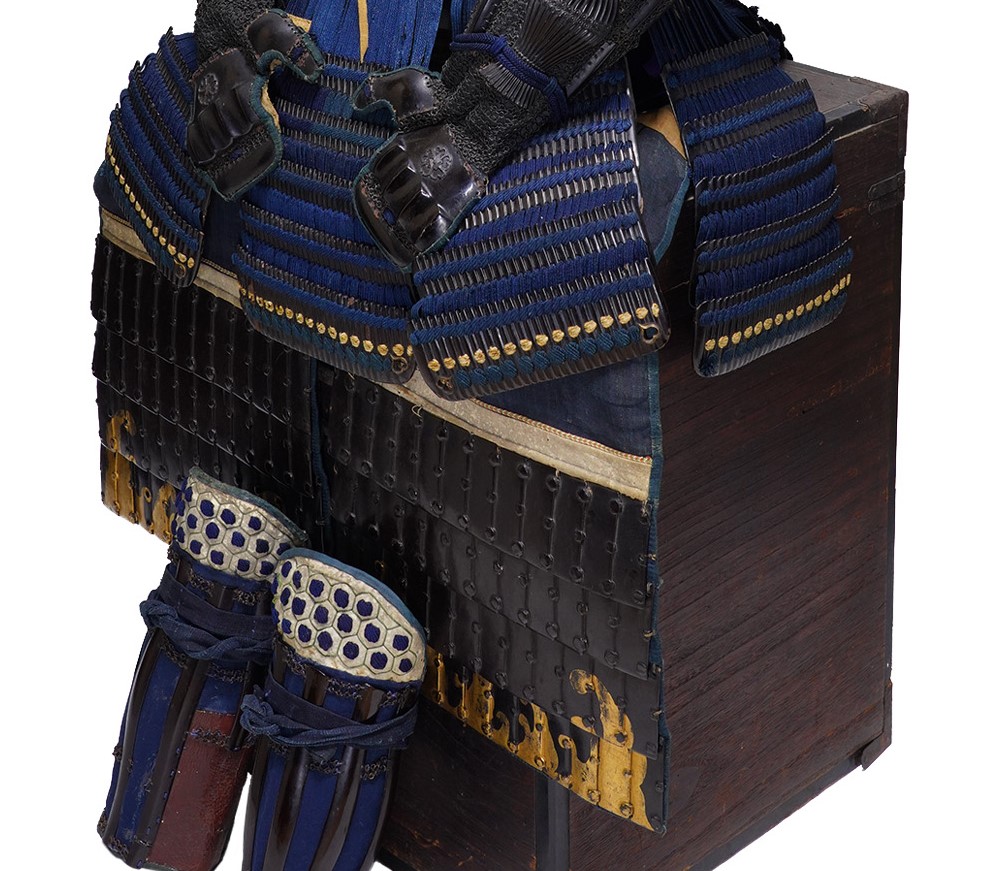
■Suneate (shin guard):
The Kikkou (亀甲, turtle’s shell) pattern is used for the cloth of the Suneate (脛当). It is a continuous geometric pattern connecting regular hexagons up and down. A theory says that this design was brought from China and the Korean Peninsula during the Asuka (592-710) and Nara periods (710-794). A proverb says turtles live long lives; therefore, turtle and turtle’s shell patterns represent longevity. In addition, as this continuous hexagonal pattern does not get out of its shape, it is said people wished for eternal prosperity by using this design.

Certification: Tokubetsu Kicho Shiryo Certificate (No. 1983)
On November 6th 2022, this armor was appraised as a Tokubetsu Kicho Shiryo by The Association for the Research and Preservation of Japanese Helmets and Armor, which is the most trusted Japanese armor appraiser in Japan. Tokubestu Kicho Shiryo means special rare article. It is ranked as the third highest of five rankings.
The paper mentions the armor was made in the mid Edo period (late 17th- early 18th century). You can receive this original authentication paper.
An English translation of the certificate is available on request. We won’t charge any additional fee.
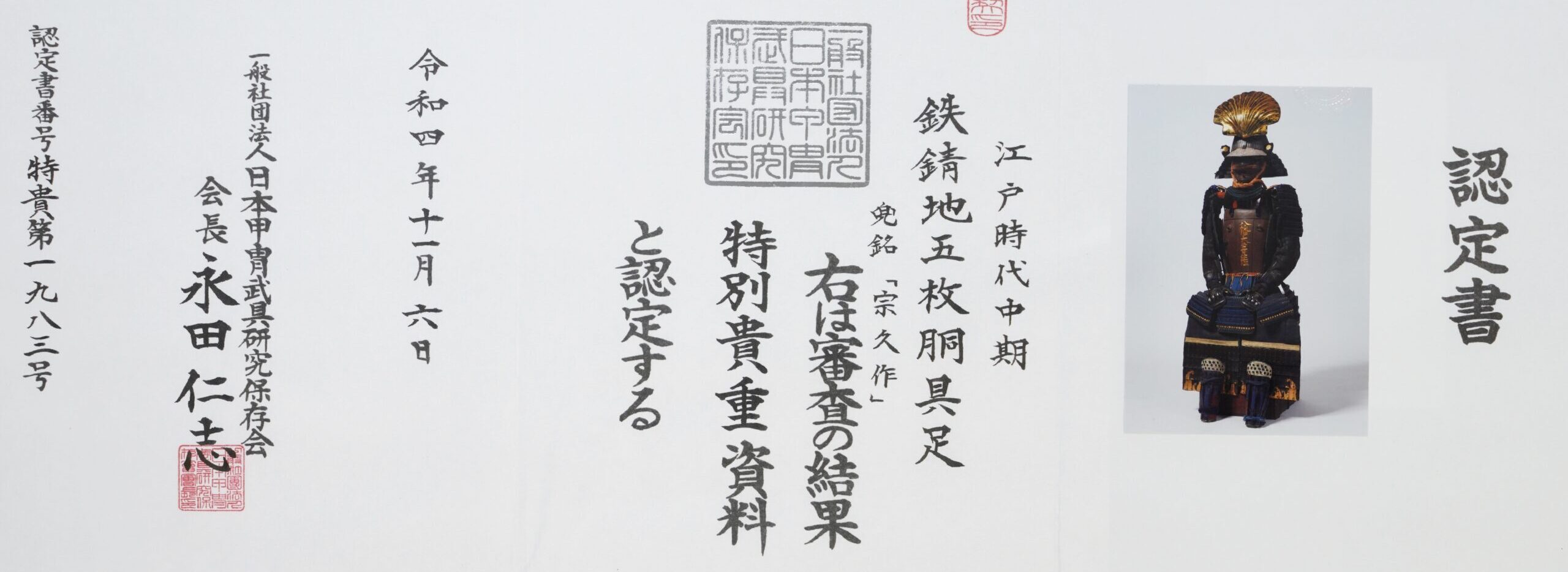
【About us】
Samurai Museum is located in Tokyo, Japan, exhibiting antique artifacts related to the Samurai history. Samurai Museum Shop is the place for those who are interested in Japanese culture and craftsmanship. We deal with antique Samurai swords/armor, traditional crafts made in Japan and so on.
【Antique Japanese Armor and Export process】
After receiving the full payment from you, we will apply for its export permit from the agency for Cultural Affairs to legally export the antique Samurai armor to other countries. It normally takes around 2-4 weeks to receive this permit. And we would like you to expect at least 1-1.5 months for your order to arrive at your given address after you ordered.
【Payment method】
We accept payment through Stripe (Credit card), PayPal, Apple Pay or ChromePay, all of which are secure payment methods. Also, you don’t need to make an account on Stripe for the checkout. If you prefer other payment method, please contact us. You may either pay in JPY, USD, AUD, CAD, EUR, CHF or GBP. The price is set in Japanese Yen. Prices in other currencies are automatically calculated based on the latest exchange rate.

【Shipping duration】
We normally ship via EMS (Express Mail Service) provided by Japan Post. It usually takes at least 5-14 days to deliver the package after you place an order. We offer Free International Shipping as long as we can ship your order by EMS. If you prefer other shipping carriers, please contact us.
We will inform you of the order’s tracking number via email. Please make sure you fill out your valid email address correctly.
*Please keep in mind that due to the spread of COVID-19, there might be possible delays in delivery. If you like to make sure if EMS shipping is available to your country, please contact us.

【How to make sure the condition】
Please keep in mind that what you are going to purchase is an antique item. We uploaded high resolution photos for you to check its condition thoroughly. If you like to see more photos with different angles, please feel free to contact us. We will be happy to send them to you so that you can make informed decision. It is essential for us to know that you are happy with your choice of a sword. and we are prepared to use the best of our ability to serve you.
【How To Contact Us】
Please contact us through email, Facebook Messenger or Live Chat if you have any questions. You can find each icon on the right side of the website. Please click one of them to reach us. We will reply to you within 1-2 business days.
【How To Preserve Antique Samurai Armor】
Dryness, humidity, and bad ventilation might deteriorate the condition of antique Samurai armor. The best temperature to preserve Samurai armor is around 20℃ in Celsius, and humidity should be about 60%. Direct sunlight should be avoided. We recommend storing armors in a room with good ventilation. If you like to display them outside the boxes for a prolonged time, we suggest using a glass case in order for dust not to be accumulated easily. In case you don’t use a glass case, please make sure to regularly dust off from the armor by using a soft brush made of delicate cloth or brush for painting.
If you like to know more about the preservation of this armor, please feel free to contact us.

